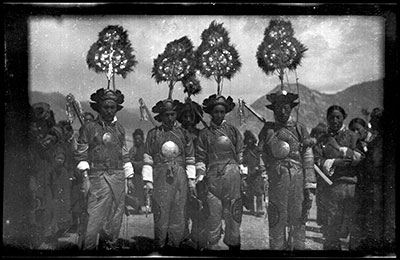
2001.59.3.31.1 (Film negative)


2001.59.3.31.1 (Film negative)

Hugh E. Richardson
Hugh Richardson
Mid-late 1940s? c.1946?
Lhasa > Trapshi
2001.59.3.31.1
85 X 56 mm
Negative film nitrate
Donated August 2001
The executors of the estate of Hugh E. Richardson
Hugh E. Richardson
Manual Catalogues - Notes on negative album - '3' 'MUG, LHOBRAG GORGE. GYANTSE. KHAMPA DANCERS. CHIPSHA MEN, CHOPA, APSOS, DREPUNG. NORBULING. DEKYI. POTALA'
Manual Catalogues - Notes on negative index - 'do. [Chipsha Loamu [?sic]]'
Research publication - "Group of men from an aristocratic estate dressed up old military costume for taking part in the New Year Ceremonies". David Snellgrove and Hugh Richardson, A Cultural History of Tibet , London, George Weidenfeld and Nicolson, Ltd., 1968. p. 211.
Other Information - Dates: Richardson seems to have resumed using 6x9 negatives in the mid-late 1940s and some other prints without brand names, as the contact for this print is, were developed around this time. Also, many of the images in this group of contact prints seem to have been taken at Sonam Wangchuk’s residence prior to this event, suggesting that they were taken later in Richardson’s residence in Lhasa rather than earlier, when he would usually attend such events as the guest of government. Other 6x9 contact prints without brand names can be identified to 1946 [MS 19/12/2005]
For Citation use:
The Tibet Album.
"Soldiers dressed in ancient military costume"
05 Dec. 2006. The Pitt Rivers Museum.
<http://tibet.prm.ox.ac.uk/photo_2001.59.3.31.1.html>.
For more information about photographic usage or to order prints, please visit the The Pitt Rivers Museum.
© The Pitt Rivers Museum